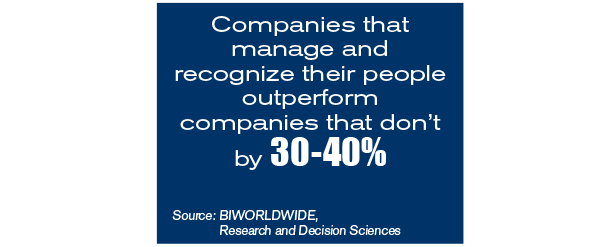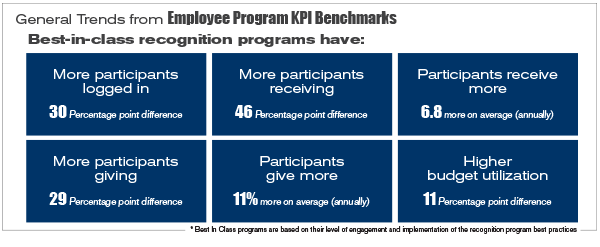What is a recognition-rich culture?
The culture of a company (or even its brand voice) is a combination of factors and influences. These include corporate and social values, core principles, attitudes, and even history.
A positive workplace culture adds quantifiable value to an organization through improved employee engagement, which leads to increased production and output.
Positive workplace cultures are often seen in tandem with recognition-rich cultures. A recognition-rich culture is basically a reflection of an organization’s appreciation for its employees’ performance, achievements, attitudes, or behaviours.
This recognition or appreciation can take many forms, but a formal recognition program publicly and regularly celebrates and rewards employees for their landmarks, milestones and successes.
What impact does a recognition-rich culture have on employee engagement?
Loyalty is a major outcome of a strategically implemented and well-executed employee recognition and rewards program. If employees feel seen, heard, appreciated, and valued, they feel less inclined to look for opportunities elsewhere. Talent retention is not only good for morale, but it also has a positive impact on the bottom line.
Building an effective employee recognition program.
Once you launch an employee recognition program, organic growth begins and is influenced by program components and strategy.
Every program is different in areas including:
– Leadership support and buy-in
– Communications
– Program investment
– Program components and structure
– Strategy
– Management training
Those programs that follow the best practices for engagement see the healthiest engagement growth.

How to create a recognition-rich culture.
To be truly successful, a recognition-rich culture needs to be adopted and embraced at every level of an organization. Recognition, rewards, and appreciation should be openly and visibly shared equally between peers, teams, leaders, managers, and executives. Genuine, meaningful recognition leads to genuine, meaningful engagement.
How does your rewards program compare to the best in class?
The sales and self-improvement trailblazer, Dale Carnegie, once wrote, “People work for money, but go the extra mile for recognition, praise and rewards.”
Carnegie’s words are an insightful and prophetic distillation of the power of a top-quality recognition and rewards program. The impact of such a program is clearly reflected in these statistics:




But it’s not enough merely to have an active program, it has to be an effective one.
Is your program delivering optimum results? Does it match the basic key performance indicator (KPI) benchmarks for best-in-class recognition and reward programs?

BI WORLDWIDE Canada (BIW) has analyzed employee recognition program data across multiple clients in order to develop comparisons that allow clients and prospects to gauge how their recognition program is performing.
BIW’s Recognition Benchmarks focus on building a culture of recognition, independent of industry, audience size or other factors, as the variations are more likely driven by difference in adoption of program best practices.
The benchmark metrics are divided into four categories:
Best-in-class programs:
Those clients who follow most or all of BIW’s guidelines for best-in-class recognition programs.
Average programs:
Those who do not follow BIW’s guidelines for best-in-class recognition programs.
Overall:
Combination of top performers and average programs.
Best-in-class by metric:
Average metrics for the top 5 programs for each metric.
